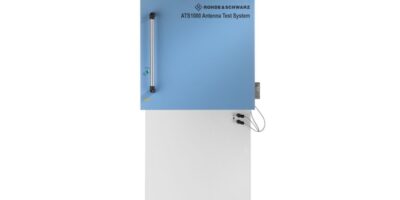Rohde & Schwarz and IHP perform D-Band characterisation
D-Band, ranging from 110 to 170GHz has been identified as a candidate frequency band for 6G mobile communications and future automotive radar applications. Rohde & Schwarz, in collaboration with research facility, IHP (Innovations for High Performance Microelectronics), claims to have performed the industry’s first full 2D/3D antenna characterisation of transceiver modules operating in the D-Band.
Networks and devices supporting mmWave frequencies, antenna systems and RF transceiver modules for 6G mobile communications standards or automotive radar applications will be challenging for testing. Factors like a wide frequency range, a greater number of antenna elements and the lack of conventional external RF connectors will demand testing over the air (OTA) in a shielded environment.
Rohde & Schwarz and IHP have transferred a test method successfully into the sub-THz range and demonstrated the first full 2D/3D OTA measurements of a radar module at D-Band frequencies.
The partnership combined an R&S ATS1000 antenna test system, an R&S ZNA43 vector network analyser and R&S AMS32 antenna measurement software in a test set up. The R&S ATS1000 antenna test system is a compact and mobile shielded chamber solution for OTA and antenna measurements, for 5G mmWave applications. To cover the D-Band frequencies, extensions from Radiometer Physics, a Rohde & Schwarz company, are used in the set up, which allow direct frequency conversion at the probe in both transmit and receive directions. No mechanical modifications or additional RF cabling to the antenna test system is necessary. The set up can measure the amplitude and phase coherent response of a device under test (DUT) radiating in the D-Band. Fully automated 3D-pattern measurements including post-processing can be performed in short time, says Rohde & Schwarz, due to the R&S AMS32 software options for near field to far field transformation and the precision positioner.
IHP provided four DUTs based on the same D-Band radar transceiver chipset but with different antenna structures, including on-chip single and stacked patches with air trenches and an on-chip antenna array. The OTA characterisation verified the wider bandwidth provided by the stacked patches than that by the single patch.
The performance of the various DUTs was characterised by spherical measurements, using two different set ups. By increasing the angular theta step-size from one to five degrees, the total test times for a DUT could be reduced from 70 to 12 minutes. By comparing the different DUT designs based on the obtained measurement data, researchers of IHP were able to analyse the effect of the finite on-board reflector area on the radar sensor FoV (field of view).
Professor Gerhard Kahmen, managing director of IHP, says: “The Rohde & Schwarz OTA test system, extended to D-Band, provides an excellent way to characterise radiation patterns of the complex antenna structures, realised in our D-Band radar chips, in a time efficient and precise way.” He explained that these measurements are valuable to understand the physics of the antenna structures and to improve their performance.
Jointly, Rohde & Schwarz and IHP’s efforts will help researchers and key industry players to test and characterise antenna systems and transceiver modules for future automotive radar applications and wireless communication standard, that will eventually be called 6G.




